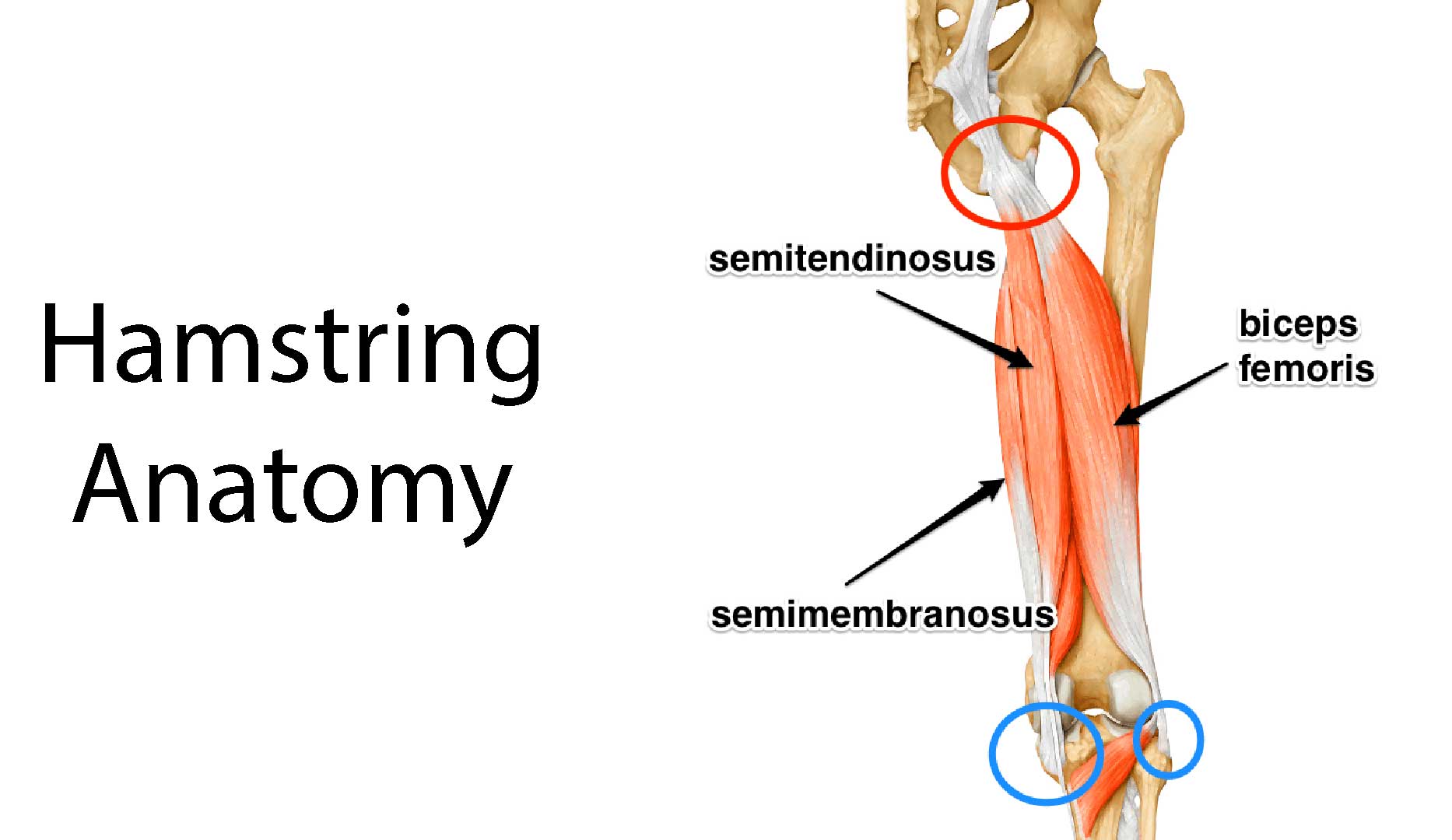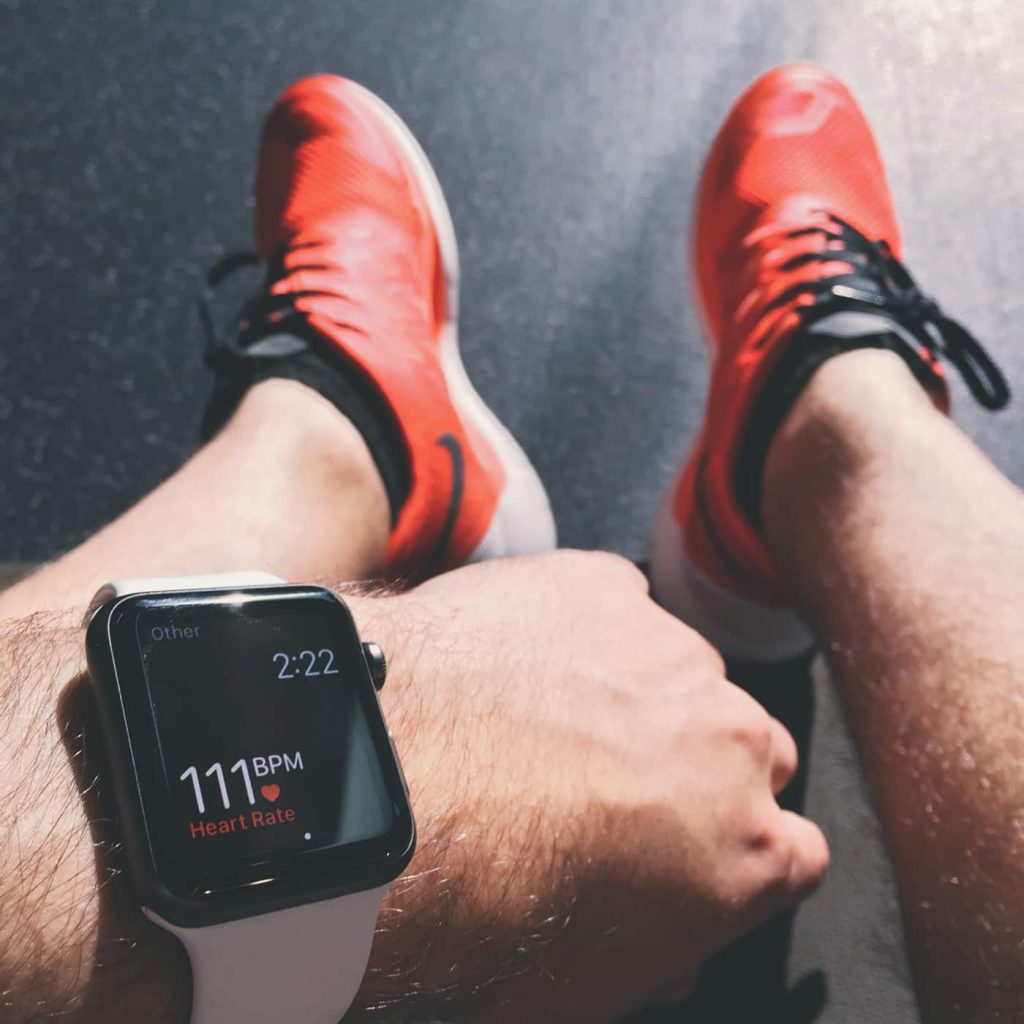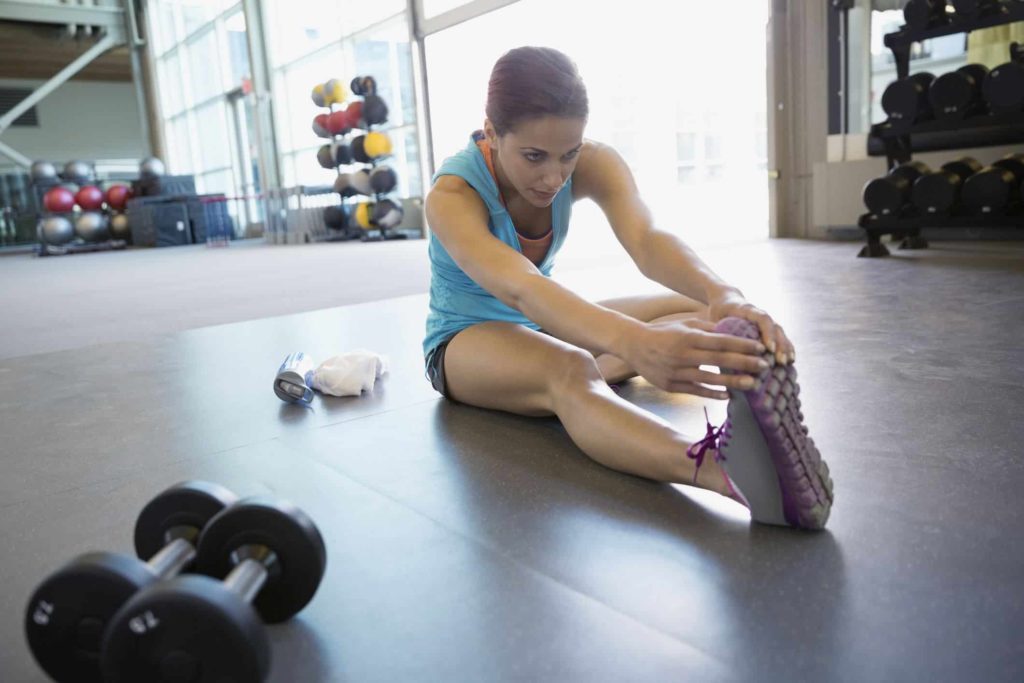What are the hamstrings?
Hamstrings are a group of muscles on the back of your thigh that get injured the most from all muscle groups in your body. You have to make sure you train your hamstrings similar to the way they function, when you are walking, running, doing your daily activities, or playing sports. This means that the exercises have to involve both the hamstrings and the glutes in order to create powerful hip extension. If you only do hamstring curls when you’re at the gym, you are asking for a hamstring strain or worse. Try the below hamstring exercises at home or even at the gym if you want to have a more stable injury free lower body.

Hamstring muscles anatomy
Hamstrings are made up of three different muscles that perform similar functions. These hamstring muscle names are the semitendinosus, semimembranosus, and biceps femoris.
- Semitendinosus originates from the sit bone (circled in red) and attaches distally to the outer upper tibia (blue circle).
- Semimembranosus also originates from the sit bone, however attaches to inner part of the upper tibia (circled in blue).
- Biceps femoris has two heads: a long one and a short one. These two originate from different places. Long head starts from the sit bone, and the short one from the back part of the femur. Their attachment however is the same for both heads. They insert outside the top of the fibular head (circled in blue).

Actions of the hamstring muscles
The first and especially relevant function of all three hamstring muscles is knee flexion. Furthermore, all of the hamstring muscles except for the short head of biceps femoris are responsible for hip extension. Another vital role is played by the hamstrings during internal rotation of a flexed knee (semitendinosus and semimembranosus) and external rotation of a flexed knee (biceps femoris).
Why you need a hammy workout?
I doesn’t matter if you’re an athlete or a regular person, you rely on your hamstrings all the time. Hamstrings are the muscles that bend your knees. If you play team sports and you have strong hamstrings, you can run faster, jump higher and accelerate quicker. Even if you are not athletic, when your hamstrings are strong, you will be able to maintain perfect posture and prevent such unpleasant things as low back pain and leg injuries. If you already sustained an injury, such as a muscle strain, or have been experiencing knee pain, you may want to try these muscle exercises as part of a recovery program. Hamstring exercises after injury can make a huge difference. Just make sure you see a doctor or a physical therapist before trying these hamstring exercises at home.
Hamstring exercises at home without any equipment
Most of these hamstring strengthening exercises are bridges and their variations, done on the floor using just the bodyweight. You will also find a lot of them to be isometric hamstring exercises. Bridges, also known as hip thrusts are are calisthenics exercises and are among the best hamstring workouts out there. These closed chain hip exercises not only load the hamstrings, but also activate the glutes, stretch the hips, and help with low back pain.
Caution: these body weight leg exercises will make you sweat and give you muscle soreness. In other words, if a hamstring workout routine too difficult, you can modify the work-rest intervals according to your abilities.
Important: While this hammy workout is body weight based with minimal to no equipment, you will need a mini-band or some type of resistance band for a few of these hamstring strengthening exercises.
In addition, before starting, make sure to find good warm up exercises. If your time is limited, it’s better to reduce your workout, not the warm up. You can jog, pedal a bike, jump rope, etc… Dynamic hamstring stretches, such as standing leg raises will work as well. These range of motion exercises are especially relevant if you have very tight hamstrings.
How to strengthen hamstrings?
Below are the 30 bodyweight hamstring exercises at home:
If you want to note down all these hamstring strengthening exercises, here they are:
- Bridge + toe taps
- Reverse plank + toe taps
- Supine plank + leg raises
- Elevated bridge + marching
- Miniband bridge + marching
- Reverse plank + marching
- One leg wall bridge + toe taps
- Reverse plank + leg raises
- Bridge walk-out
- Wall bridge walk-out
- Elevated walk-out
- Hip rocking
- Wide stance bridge + heel rotations
- Butterfly bridge
- Elevated bridge + miniband abductions
- Supine plank hovering
- Bridge + reach-overs
- Reverse saw
- One leg bridge with miniband
- One leg reverse saw
- One leg knee extension bridge
- Modified one leg bridge
- Modified single leg bridge
- One leg bridge + leg circles
- One leg bridge + heel rotations
- One leg wall bridge with miniband
- One leg wall bridge + heel raises
- One leg bridge + hip abductions
- One leg bridge + toe taps
- One leg deadlift squats
If you want even more hamstring exercises you can do at home, read this guide.
How to do this hamstring workout routine?
You can scale your hamstring workout routine based on your level of fitness. If you perform these hamstring strengthening exercises after injury, make absolutely sure you do it pain-free. First of all, select 4-5 exercises that you like and try to do them tabata style. Here is a sample routine of these hamstring exercises at home for beginners:
- Bridge + toe taps: 40 seconds on – 20 seconds off (5 sets)
- Bridge walk-out: 40 seconds on – 20 seconds off (5 sets)
- Supine plank hovering: 40 seconds on – 20 seconds off (5 sets)
- One leg wall bridge + heel raises: 40 seconds on – 20 seconds off (5 sets)
- One leg deadlift squats: 40 seconds on – 20 seconds off (5 sets)
Depending on your level of fitness choose a hamstring workout routine that will make you work really hard, and you will feel your hamstrings growing stronger each day. Be persistent and keep track of this routine, including work-rest periods, which exercises worked the best, etc. Furthermore, make sure that you wait some time (at least 48 hours) before trying this hammy workout again. This time try to work a little harder, either by increasing the number of hamstring sets, or decreasing the rest periods.

Timing your hams workout
When doing these hamstring exercises at home, your will get better results if you use work-rest periods, so you will most likely need a stopwatch or a workout timer of some sort. Do each one for 30-40 seconds and rest for 20-30 seconds. If you can handle it, perform 5-7 sets of each exercise. In fact take a break if you really have to, but try to do them all as fast as you can, making sure to have good form. If you can’t do it for 40 seconds, do it for 30, taking longer brakes, and see if you can eventually progress to 40. Make sure you feel like you are being challenged. The key here is to be consistent and perform this exercise routine regularly. Then your hamstrings will be strong and you will stay injury free.

Don’t forget to do a hamstring stretch
You always want to stretch your hamstrings and calves. Static stretching after a workout is a good idea for any muscle group, but when it comes hamstrings, this is an absolute must. The seated hamstring stretch is a good example of hamstring lengthening, and is one of the best hamstring stretches. Super tight hamstrings will pull your pelvis out of alignment, resulting in lower-back pain and injury. Nearly all of us will deal with low back pain at some point of our lives, hence hamstring stretching exercises is what you need to lengthen the muscle tissue that became tight during the work-out. Some may also find gentle stretches for sore hamstrings to be beneficial for delayed onset muscular pain.

I biiiiig thanks for this video and all the explanations.🤗
Glad to know ya’ll and much appreciated this creative and equitable concepts
Thanks 🙂